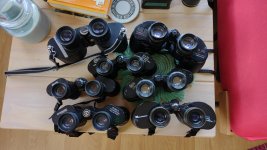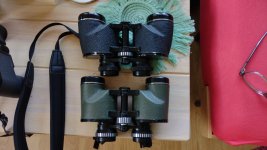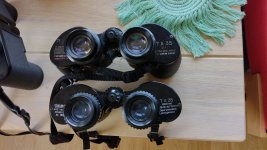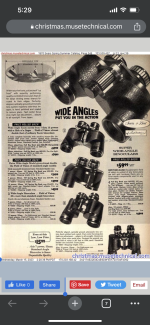So back on topic (why do I so often click "show ignored content"? I should really stop doing that

).
I got out some of my wide angle porros and compared a few of them.
From 11°, 7x35, to 8x30, 10°, 7x35 with 10.5°, etc.
A factor that I think has not been mentioned is prism size -- but that is mostly irrelevant for modern roofs.
It is very obvious however for porros. The 11°, 7x35 is a real monster. It handles just fine for me but I have large hands.
I have a tiny Optolyth 8x30 with a smallish FoV which is very light-weight, so ideal for taking on hikes or strolls through the city. I think it has around 450gr.
The suprise was a humble old Tasco 7x35 with 10.5° according to specs.
It offered one of the most balanced views of the porro EWAs that I own. The field stop is still visible, eye-relief is good enough so my eyelashes don't touch the glass, field curvature as well as pincushion are kept at low levels that don't interfere with a balanced view. On some models the pincushion distortion is so high, when you constantly switch between things near you and farther out, the edges of the FoV bend up and down. Can be irritating for some people who might get seasick.
The obvious effect of the largest FoV models is the degradation of the edges to a point where even I think it might no longer be all that useful to increase it even further. I never looked through one of the old 12.5°, 7x35 models, for example sold under the "Sears" brand. Those were never sold in europe. The 7x35 EWAs are rare.
And even between 10.5 and 11° there is a noticable increase in size of the bino itself.
Another great model is my Kamakura-made 8x40 with quick focus and 157m/1,000m -- so around 9° FoV. It is also pretty well balanced when it comes to pincushion and field curvature. Also rather bright compared to some older models, even though it seems to have single coatings.
So long story short -- for the old porros, I think between 9° and 10.5° seems to be a sweetspot for me, considering the balance between curvature, pincushion, eye relief, as well as size of the bino itself.
Some pics of the porros I compared. You can easily see the size difference of the ones with the largest FoV to the models with a more moderate FoV.
The two with the largest FoV are on top. The "Olympia" on the left has 210m/1,000m but the edges do degrade rather severely.
It still is a nice view though.
As mentioned before, only the inner 2° of our personal FoV is actually sharp. Movement can be noticed just as well with "fuzzy edges" and the bino then recentered.
I still love my flat-field models that I bought for stargazing.
But these old porros just have a certain, je ne sais quoi. The sharpness in the center, the 3D-effect (do people still remember when Dennis was all about the 3D-view of his Nikons? Fuzzy edges be damned), the handling. I love all of them.
But do I miss the wider FoV when using my beloved Fuji HC 8x42 with a measly 8°? Not really.

11° "Adler" vs. 10.5° Tasco.












